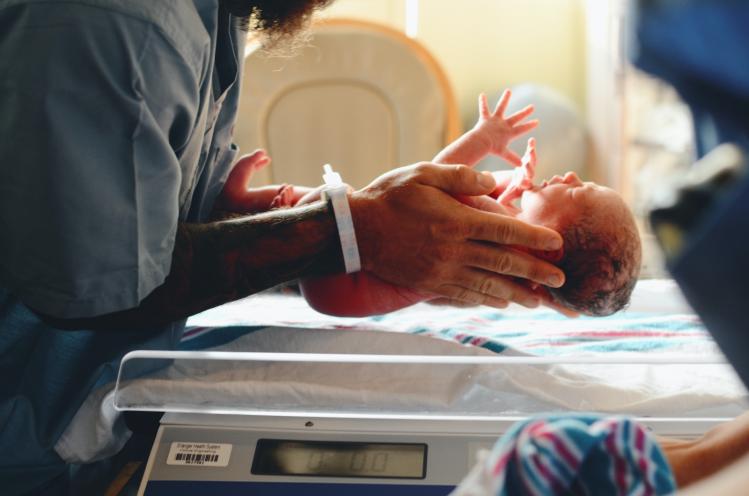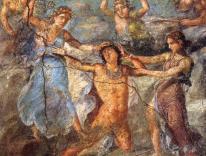
Interested in discussing this article in your classroom, parish, reading group, or Commonweal Local Community? Click here for a free discussion guide.
Adam Kirsch’s examination of “Anthropocene antihumanism” and “transhumanism”—two quite different ways of revolting against humanity and welcoming the end of human life as we know it—is readable, informative, and bracing. Nonetheless, it ends not with a bang but a whimper, suggesting that even a true humanism might have to welcome, albeit sorrowfully, a world in which human beings no longer exist. Perhaps, however, before endorsing a prescription of species-suicide we should at least consider what insight Christian faith might offer.
Kirsch’s concluding chapter is titled “The Sphere of Spiritual Warfare.” And he is, in fact, depicting what might almost be called competing religious views. According to antihumanists, our species has exploited and despoiled the natural world, and our “disappearance would be a net benefit to life on earth.” The best thing we could do is to stop giving birth to others like us. Transhumanists, with their technocratic confidence in scientific progress, might at first seem to be the polar opposite of antihumanists. But not really. Their goal is to get beyond the limits of the body, tied as it is to organic life, and then experience a “virtual” existence, having uploaded to a computer the pattern of information that is one’s brain. If there is a sense in which this approach hopes for a continued existence, it is no longer what we normally think of as human existence. Hence, Kirsch writes, beginning from very different premises, “transhumanists and antihumanists could converge on an ideal of extinction, with rapacious humanity making way for wiser virtual beings who tread more lightly on the planet.”
From the perspective of either of these two seemingly different yet converging views, what is the real problem with the continued existence of our species? In a word: birth. The transhumanists have a vision of virtual human nature that makes it unnecessary. The antihumanists hope for a human destiny that will exclude it. In her poem “The Risk of Birth,” Madeleine L’Engle captures the despair of what Kirsch calls Anthropocene antihumanism and the gnostic dream hidden beneath the desire of transhumanism to slip the bonds that tie us to organic, bodily life.
This is no time for a child to be born,
With the earth betrayed by war & hate
And a comet slashing the sky to warn
That time runs out & the sun burns late.
What, if anything, can we set over against such a reluctance to give birth, to commit ourselves not just to the continuation of “intelligent life,” but to the survival of Homo sapiens in particular?
Perhaps an old-fashioned humanism of the sort Kirsch seems to favor? Will it do? He characterizes such humanism as a belief that “the individual human being is the source of all value” (my italics). And, of course, that little word “source” suggests that this approach, too, has a religious flavor. But Kirsch himself is not optimistic that such a humanistic commitment can or should survive in the coming spiritual warfare; for it seems to encourage us to set “an arbitrary limit to progress.” And doing that, he claims, is “the classic posture of the reactionary” and is “fundamentally incompatible with the principles humanists claim to honor—freedom, reason, moral autonomy.”
I myself do not think Kirsch’s understanding of humanism is adequate. To see why, we can ask whether setting limits to progress is always best characterized as arbitrary or reactionary. Kirsch’s example of such an arbitrary drawing of a line in the sand is Leon Kass’s well-known appeal to “the wisdom of repugnance” in opposition to proposals for human cloning. Such wisdom, going beyond what reason alone can demonstrate, may, Kass suggested, help us to honor moral limits that are integral to our humanity.
We should not dismiss this suggestion too quickly, for it invites us to wonder whether human reason alone will suffice as a source of either moral insight or a full understanding of human nature. “The head rules the belly through the chest,” C. S. Lewis wrote in The Abolition of Man. That is to say, rational insight and argument alone cannot enable us to live well. There is a humility here that draws back from thinking of ourselves as the source of all value. On the contrary, a rightly ordered life depends on trained emotions that control and shape our desires, enabling us to love what is good and experience repugnance at what is evil. Aristotle said that only one who has been brought up well—one in whom those trained emotions have been inculcated—can usefully study ethics. We might add that only such a person can usefully consider what limits are essential to our humanity. Without good moral habits, reason may simply lead us astray. And the first such habit that we need is a commitment to the goodness of human, bodily life—a sense of its centrality to both human nature and destiny.
Of course, this way of thinking is not obvious to everyone. “It is a loathsome and cruel trick,” Mike Treder once wrote, “that nature takes such an exquisitely wondrous creation as the human brain and imprisons it inside the weak, inefficient, fragile, and short-lived structure that is the human body.” But we inculcate a contrary belief—a belief in the goodness of human, bodily life—every time we hear and take to heart the Johannine teaching, “In the beginning was the Word, and the Word was with God, and the Word was God…. And the Word became flesh and dwelt among us.” Since God has a human body, we need not run from our own bodies and their limits in the way transhumanists recommend. Moreover, in the resurrected Jesus we are given an intimation of the destiny of those bodies. They have a future. Christians honor human life not because it is the source of all value, but because it has been honored by God and drawn into the divine life.
Given that sort of commitment to human life as embodied life, we should think of the body as integral to who we are, not just as a prosthesis used by our real, disembodied self. We can then come to appreciate the way an embodied life is also an embedded life—embedded in a series of relationships that involve both coming into being and going out of being. Having a beginning, middle, and end, our lives take a narrative shape that is more than just a succession of bare, momentary presents. After all, even without the transhumanist dream of a virtual existence, a desire to overcome that “short-lived structure that is the human body” can threaten to make nonsense of life. The philosopher Larry Temkin once made this point in an arresting thought experiment: “As things stand today, the physical, psychological, and experiential gap between a grandmother at sixty, a mother at thirty-five, and a daughter at nine is enormous. But the physical, psychological, and experiential gaps between a grandmother at 10,060, a mother at 10,035, and a daughter at 10,009 would be practically inconsequential.” Embodied life has a shape. Memory and anticipation—as well as the virtue of hope—are built into lives that take the risk of birth. Appreciating and embracing those risks and limits lies at the heart of a true humanism. We can and should set it over against the transhumanist desire to overcome human nature rather than honor it.
If transhumanists move us to think in particular about human nature, antihumanists direct our attention more to human destiny. As transhumanists hope for a “human” future that is bodiless and virtual, in a quite different way antihumanists would prefer that human bodies simply cease to exist. They do not want to take the risk of birth. We should always remind ourselves that rejecting such antihumanism does not mean supposing that earthly human life as we know it will or should endure forever. “Anyone who intends or perceives the world as a Christian,” Paul Ramsey once wrote, knows that “one day there will be none like us to come after us.... The Revelation of St. John is still in the Bible.”
Written into our nature is the hint of a greater destiny than continued earthly existence as we now experience it. In the words of a character in Wallace Stegner’s novel The Spectator Bird, “[a] reasonably endowed, reasonably well-intentioned man can walk through the world’s great kitchen from end to end and arrive at the back door hungry.” That eros, that hunger buried deeply in our nature, is the hint of a destiny that has been given shape and form in the Word made flesh, who was given into death and raised to a new, transfigured life.
Hence, Christian hope for a human future is not simply anti-antihumanism. It is not hope for more of the same, more of the life that is ours here and now. Nor is it hope for a future produced by the ingenuity of those who imagine themselves the source of all value. It is hope for a qualitatively different life—though, of course, what our freedom and reason cannot produce, we also cannot fully imagine. In that respect we will always be a little like the small boy C. S. Lewis described who, “on being told that the sexual act was the highest bodily pleasure, should immediately ask whether you ate chocolates at the same time.” What a new creation and a resurrected life will be like we cannot fully fathom, but what we need in the face of such mystery is clear. We need commitment to what is truly human, even as the Logos of the universe, the Word who was with God from the beginning, committed himself to us and took our human nature into his person. The whole of L’Engle’s “The Risk of Birth” beautifully expresses such commitment.
This is no time for a child to be born,
With the earth betrayed by war & hate
And a comet slashing the sky to warn
That time runs out & the sun burns late.That was no time for a child to be born,
In a land in the crushing grip of Rome;
Honor & truth were trampled to scorn—
Yet here did the Savior make His home.When is the time for love to be born?
The inn is full on the planet earth,
And by a comet the sky is torn—
Yet Love still takes the risk of birth.
The virtues that we need are, as always, three. Faith that sees gift and grace at the heart of human life and that seeks, in turn, to be faithful to the gift we have been given. Hope that looks to the future, grateful for God’s embrace of our human life, and generates others like ourselves. Love that does not cling to the gift of life, keeping it for ourselves, but gladly hands it on, taking the risk of birth.
This piece was published as part of a symposium about The Revolt Against Humanity. For more of the symposium, read:
- John F. Haught on how human thought is integral to, not separate from, the arc of the universe
- Nolen Gertz on how both anti- and transhumanism avoid political and moral responsibility
- Frank Pasquale on deflating the image of AI that underlies transhumanist fantasies
To see the full collection, click here. To listen to an interview with Adam Kirsch on the Commonweal Podcast, click here.
Please email comments to [email protected] and join the conversation on our Facebook page.
Previous Story
Poem | Pebble
Next Story
Mixed Feelings

